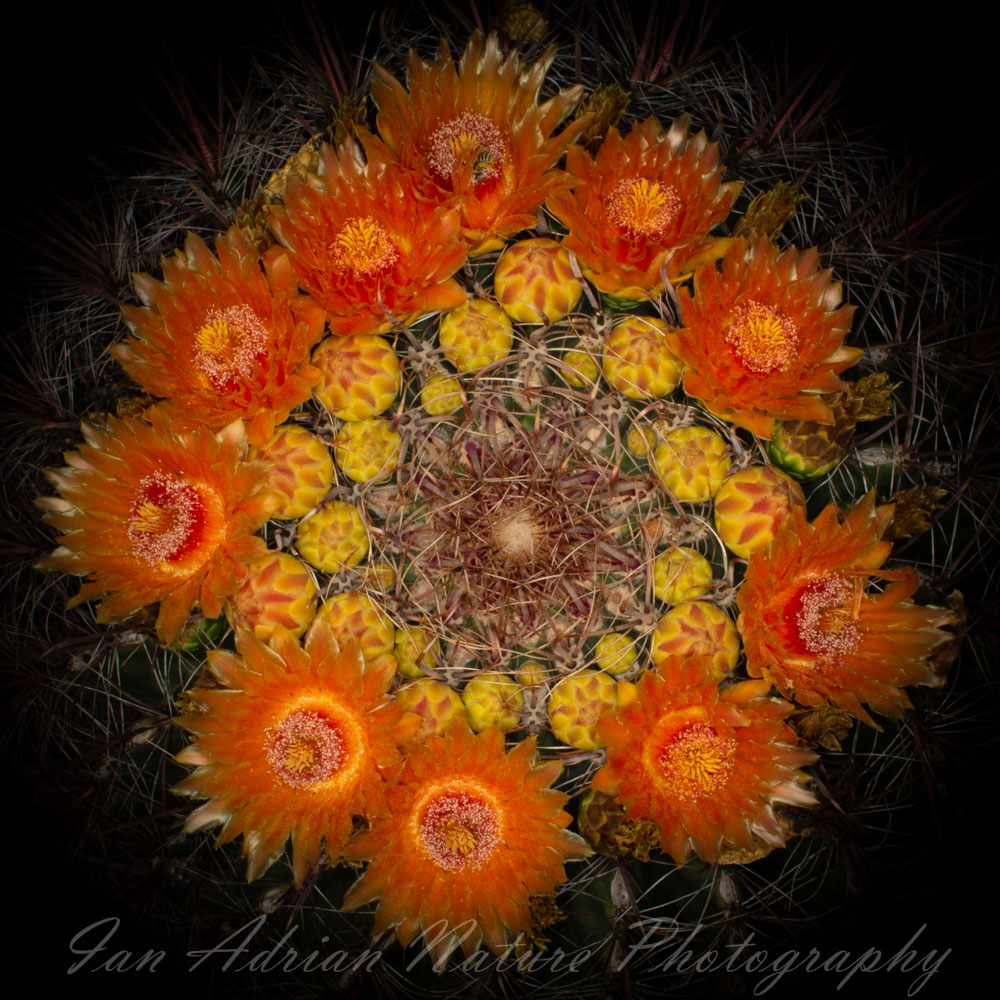
Orange Barrel
Presenting one of my favorite succulent flower displays, the barrel cactus comes in yellow, orange, and red. Barrels have a unique relationship with the ground squirrels who thrive on their fruit. It is widely suspected that the fishhook barrel developed hooked, downward-pointed spines specifically for this reason. The ground squirrel is willing to navigate a sinister gauntlet of downward spines for the reward of hearty, nutrient-rich fruit. Only in times of famine, is it worth the effort for the leafier flowers.
Photographed near Picture Rocks, AZ.
Purchase This Print

Red Barrel
Presenting one of my favorite succulent flower displays, the barrel cactus comes in yellow, orange, and red. Barrels have a unique relationship with the ground squirrels who thrive on their fruit. It is widely suspected that the fishhook barrel developed hooked, downward-pointed spines specifically for this reason. The ground squirrel is willing to navigate a sinister gauntlet of downward spines for the reward of hearty, nutrient-rich fruit. Only in times of famine, is it worth the effort for the leafier flowers.
Photographed near Picture Rocks, AZ.
Purchase This Print

Flowers on a Barrel
Presenting one of my favorite succulent flower displays, the barrel cactus comes in yellow, orange, and red. Barrels have a unique relationship with the ground squirrels who thrive on their fruit. It is widely suspected that the fishhook barrel developed hooked, downward-pointed spines specifically for this reason. The ground squirrel is willing to navigate a sinister gauntlet of downward spines for the reward of hearty, nutrient-rich fruit. Only in times of famine, is it worth the effort for the leafier flowers.
Photographed near Picture Rocks, AZ.
Purchase This Print
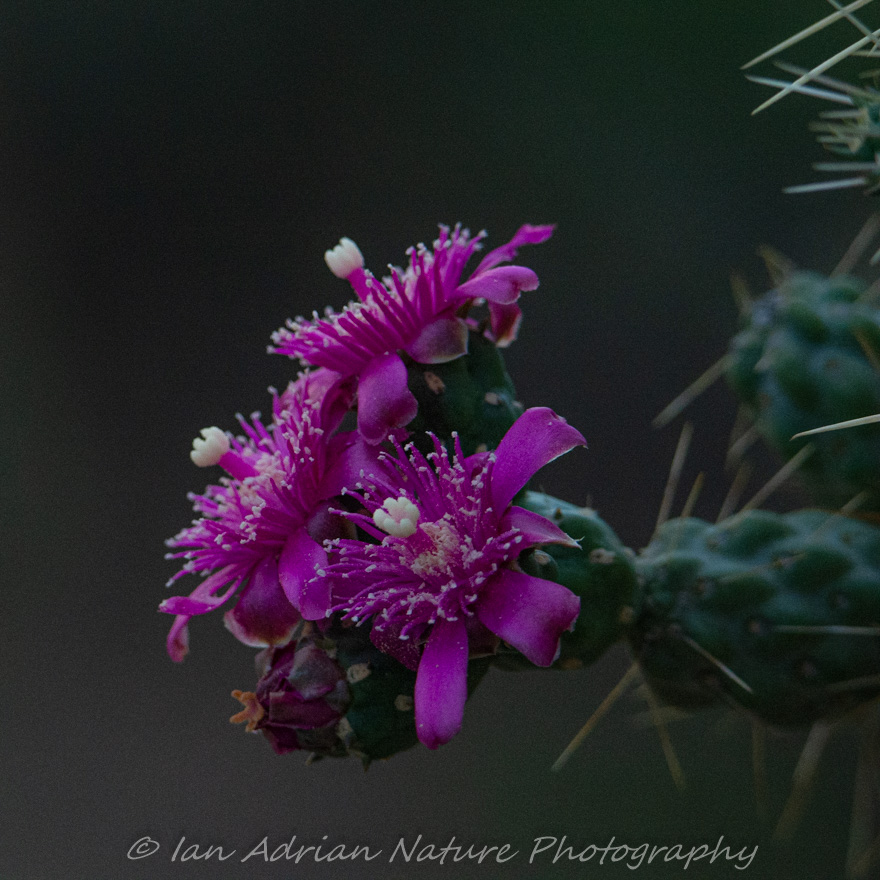
Jumping Cholla
These sinister plants are known for their tendency of hooking the hapless passerby from the gentlest touch. The transplant then hitchhikes until it's painful, barbed spines are broken or dislodged. They are sometimes carried a great distance by larger desert animals, much to the chagrin of the vessel. Saguaro National Park, AZ.
Purchase This Print

Pencil Cholla
The beautiful flowers of the slender, painful pencil cholla. Cholla cacti seem to have relationships with specific bee species in a region. The cholla is often dependent on these select bee species for her survival. Saguaro National Park, AZ. Prints of this image are not currently available. Please check back for future availability!
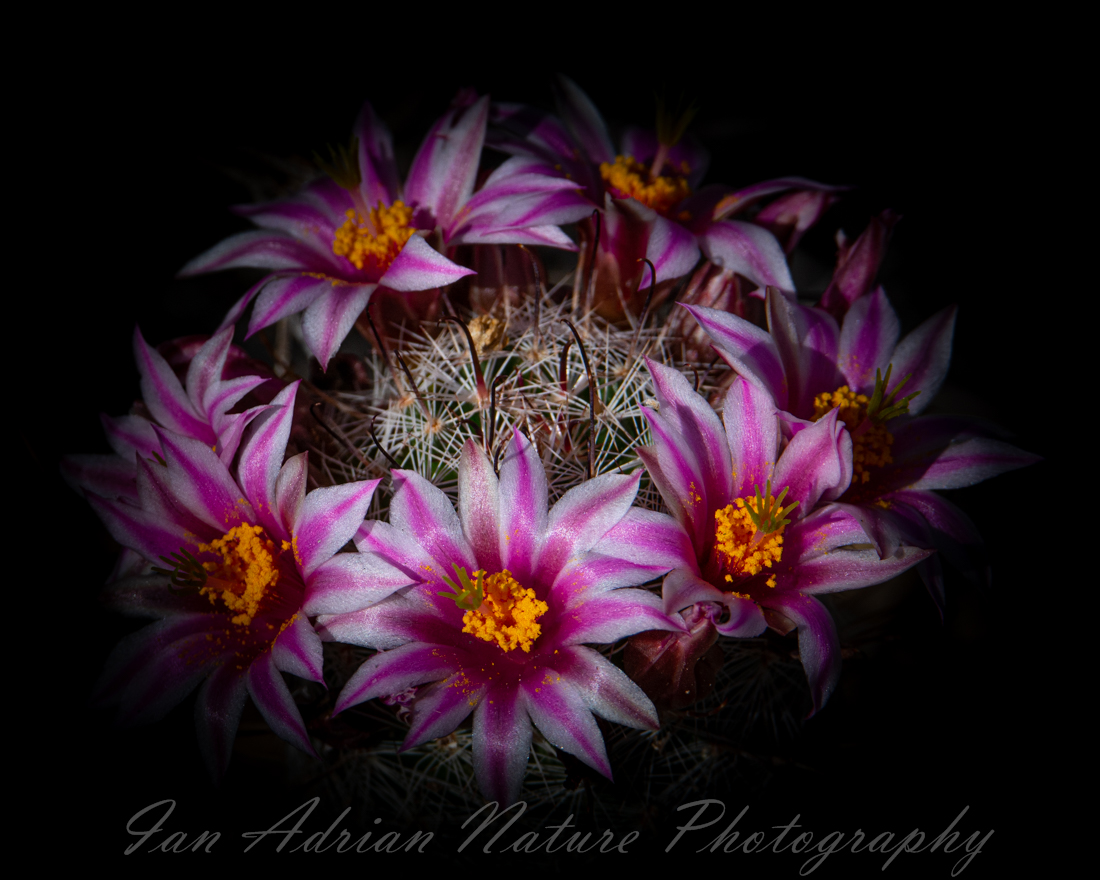
Pincushion Flowers
The tiny pincushion cactus isn't so easily overlooked when showing off a full bouquet of flowers! Along with the formerly-pictured hedgehog, pincushion cactuses are among our most beautiful prickly flower-bearers.
During much of the year, these miniatures can be nearly invisible, but for a short springtime window, everything changes. Saguaro National Park West, AZ.
Purchase This Print
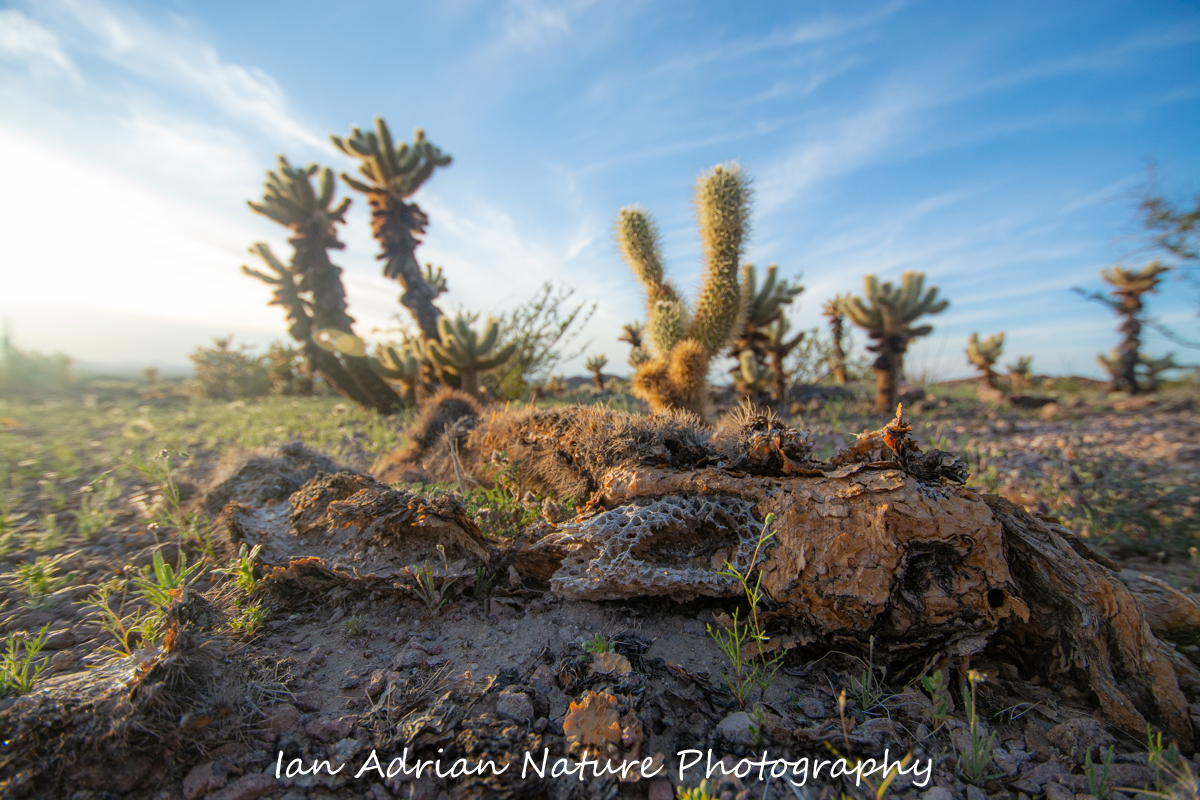
Fallen Comrade
A single fallen cholla has already shed her spiny skin. All that now remains is the beautiful skeleton, as the material from this body slowly enriches the desert's nutrient-sparse soil. Kofa Wildlife Refuge, AZ.
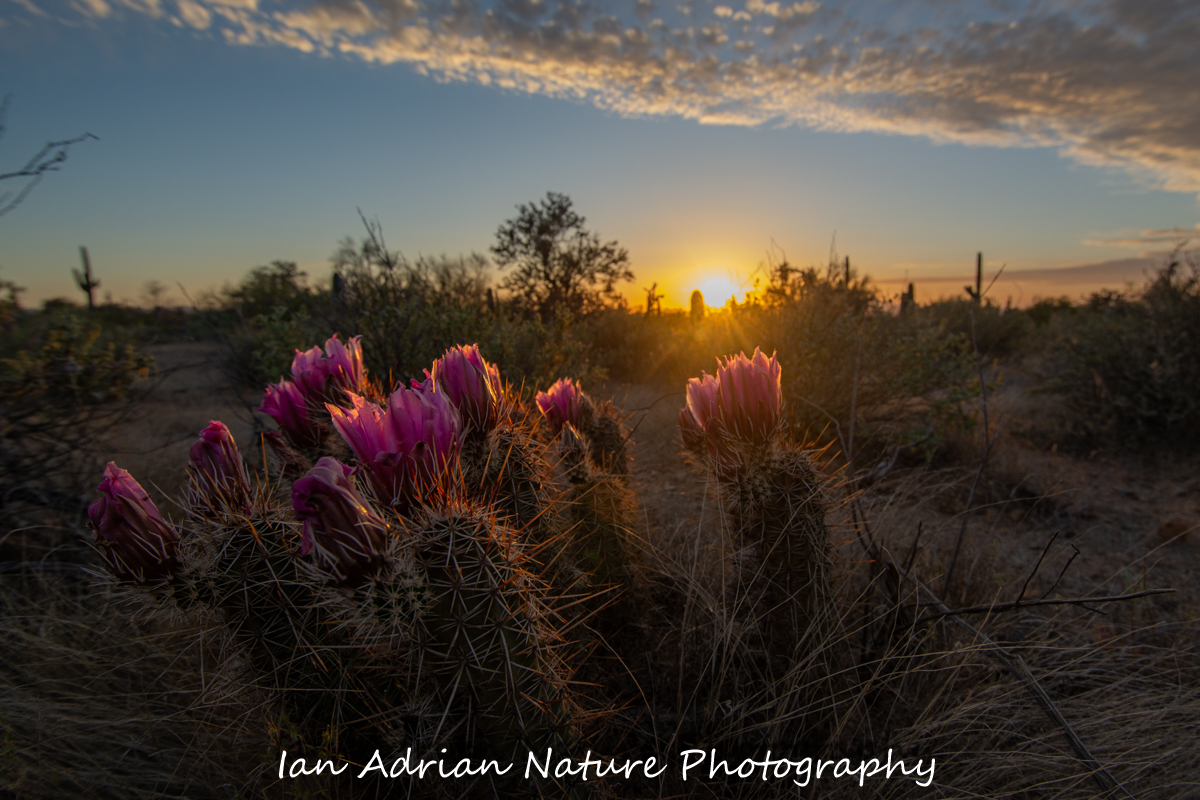
Hedgehogs at Dusk
When joined by the brilliant orange light of another vanishing sunset, the blooms of a strawberry hedgehog are no longer the exclusive highlights of this scene. Saguaro National Park, AZ.
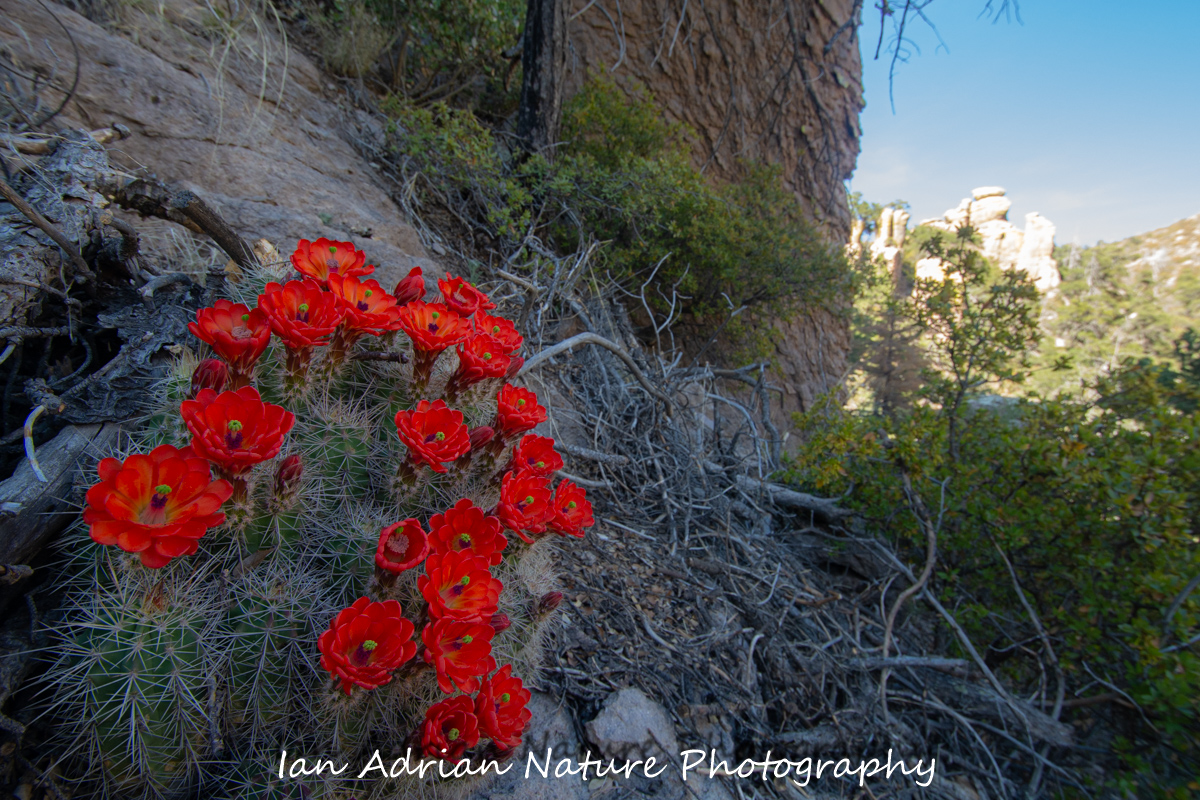
Chiricahua Claret
Choose the right spring day and the already inspiring landscape of the Chiricahua Mountains may be further enhanced by blooming claret cup cacti. Chiricahua National Monument, AZ.

Bishop’s Hat
The flower of a bishop's hat cactus, observed at the Tucson Botanical Gardens, AZ. This stunning little cactus is native to the Mexican highlands.
Purchase This Print

Flowers on a Hedgehog
The tiny strawberry hedgehog cactus produces a dazzling display of dramatic flowers. Hedgehogs seem to prefer rocky terrain, often on hillsides. These lovely flowers were likely aided by a generously-wet winter. Saguaro NP West, AZ.
Purchase This Print

Alien Face
The two eyes are easy to see, but gaze for another moment and you may notice a smiling mouth. It always brings me such joy to see plants that wear a personified face!
Tucson Botanical Gardens, AZ, USA.
Purchase This Print

The Mighty Saguaro
A beautiful Saguaro Cactus, adorned with her captivating flowers, sits overlooking the desert. Many would consider saguaro cacti the iconic mascot of our beautiful Sonoran Desert. Her flowers provide food to insects and birds, her fruit feeds many more, and her thick skin provides refuge for owls and woodpeckers.
Even in death, this cactus provides shelter for ground-dwellers, and an entire ecosystem within her decomposing innards.
Saguaro Nat Park, AZ.
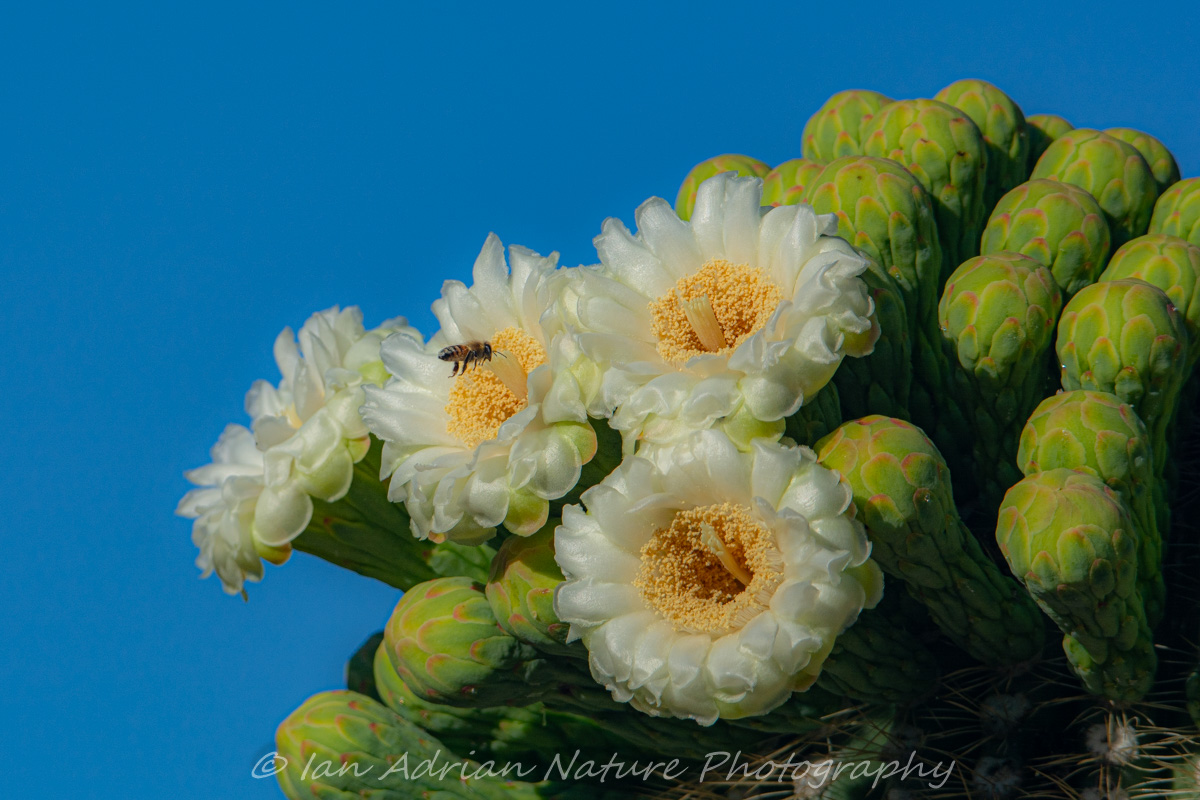
Saguaro Flowers
Springtime in the desert is a stunning scene! As temperatures soar into the 90's, the poppies and lupine of early spring are quickly replaced by flowering cacti. Among these cacti are the massive saguaros, the icon of our beautiful Sonoran Desert. Their thick bodies offer refuge to a number of birds, following the oh-so-common excavations of gila woodpeckers. The flowers offer nectar and pollen to untold numbers of birds and insects. The fruit feeds many more creatures, especially after falling to the ground where it's within reach of javelina, coyotes, and rodents. Even in death, the mighty saguaro holds moisture which contains entire ecosystems, while reptiles hide underneath to escape the intense daytime heat. Saguaro Nat Park, AZ.
Purchase This Print
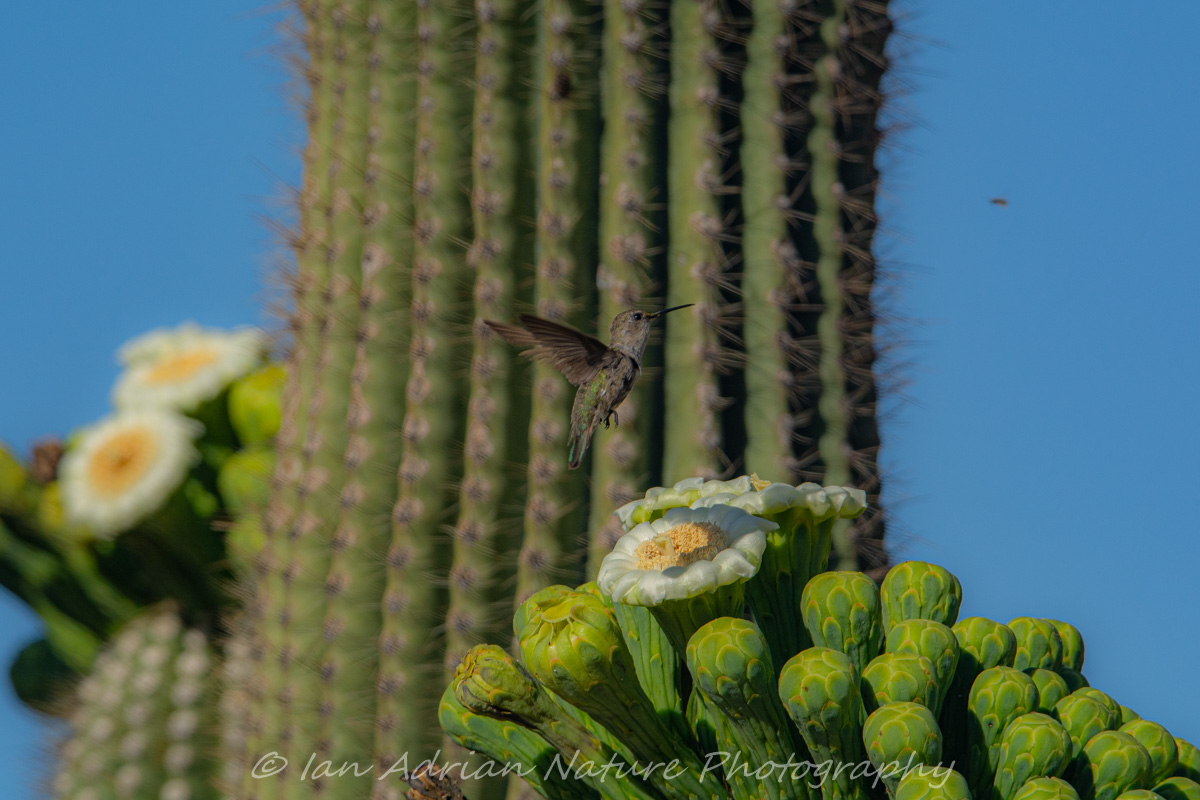
The Bird and the Bee
Like so many other desert creatures, this hummingbird and the nearly invisible honey bee enjoy the gifts of their saguaro host. Many would consider saguaro cacti the iconic mascot of our beautiful Sonoran Desert. Her flowers provide food to insects and birds, her fruit feeds many more, and her thick skin provides refuge for owls and woodpeckers.
Even in death, this cactus provides shelter for ground-dwellers, and an entire ecosystem within her decomposing innards.
Saguaro Nat Park, AZ. Prints of this image are not currently available for sale. Please check back for future availability!
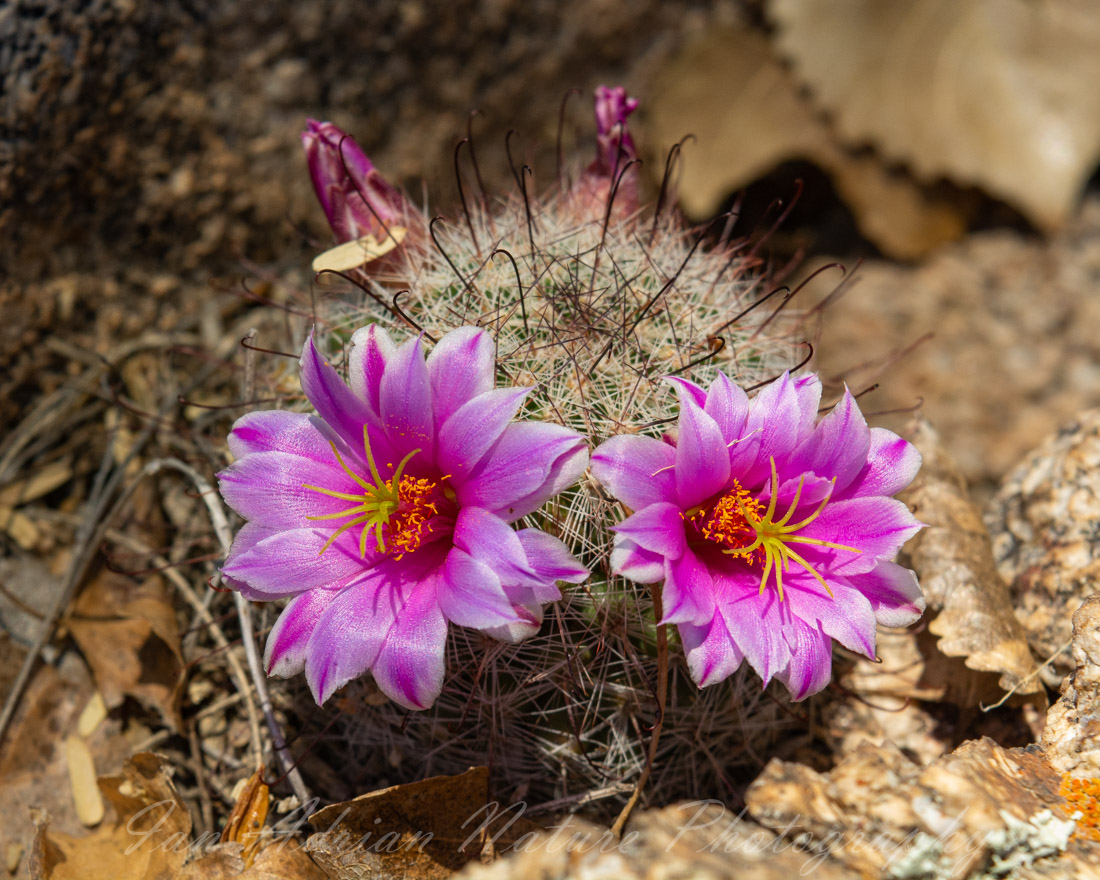
Cactus Eyes
A small pincushion cactus shows off her lovely eyes (ahem *flowers*). Along with the formerly-pictured hedgehog, pincushion cactuses are among our most beautiful prickly flower-bearers.
During much of the year, these miniatures can be nearly invisible, but for a short springtime window, everything changes. Saguaro NP East, AZ
Purchase This Print
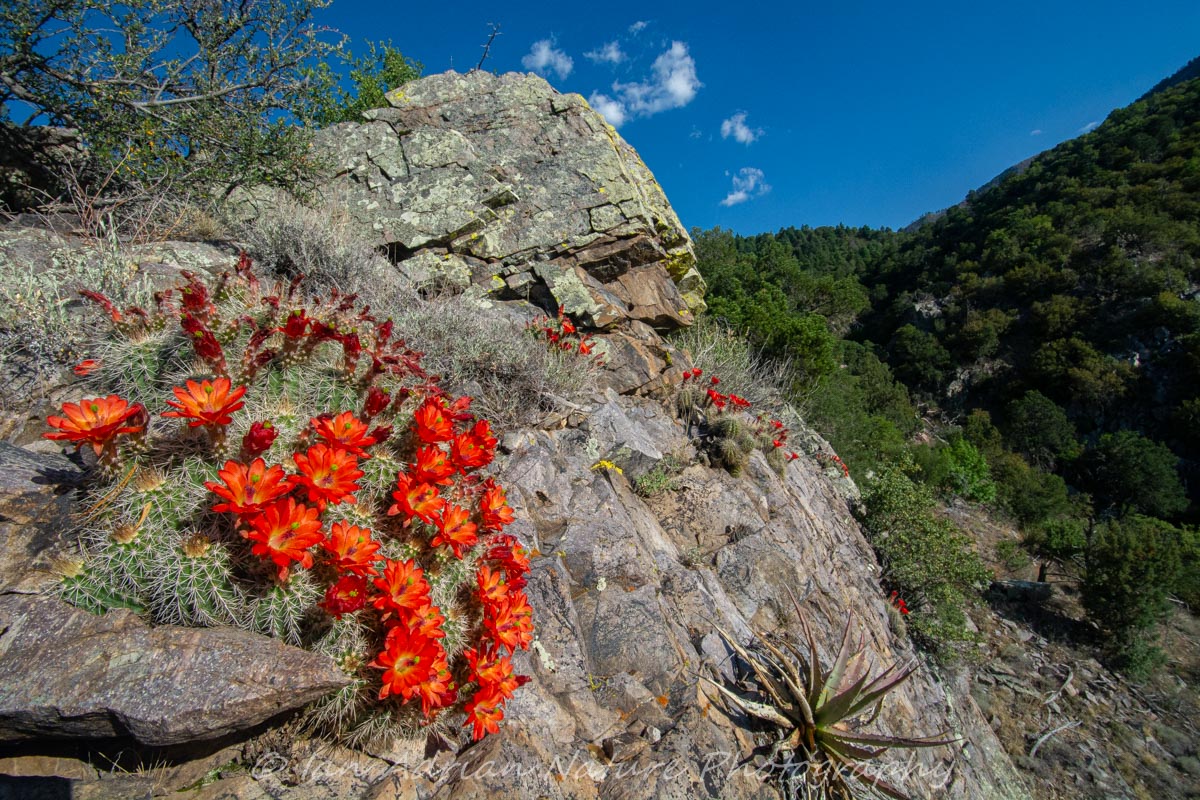
Claret Cups
These beautiful, tiny cacti are considered "hedgehogs." This species often thrives in steep, rocky habitats. Snapping this picture involved hanging off a mountainside, camera focused in the other hand. The experience is always worth the risk. Box Canyon, AZ.
Purchase This Print

Ring of Flowers
The tiny pincushion cactus isn't so easily overlooked when showing off a full bouquet of flowers! Along with the formerly-pictured hedgehog, pincushion cactuses are among our most beautiful prickly flower-bearers.
During much of the year, these miniatures can be nearly invisible, but for a short springtime window, everything changes. Saguaro National Park West, AZ.
Purchase This Print

Orange Barrel
Presenting one of my favorite succulent flower displays, the barrel cactus comes in yellow, orange, and red. Barrels have a unique relationship with the ground squirrels who thrive on their fruit. It is widely suspected that the fishhook barrel developed hooked, downward-pointed spines specifically for this reason. The ground squirrel is willing to navigate a sinister gauntlet of downward spines for the reward of hearty, nutrient-rich fruit. Only in times of famine, is it worth the effort for the leafier flowers.
Photographed near Picture Rocks, AZ.
Purchase This Print

Red Barrel
Presenting one of my favorite succulent flower displays, the barrel cactus comes in yellow, orange, and red. Barrels have a unique relationship with the ground squirrels who thrive on their fruit. It is widely suspected that the fishhook barrel developed hooked, downward-pointed spines specifically for this reason. The ground squirrel is willing to navigate a sinister gauntlet of downward spines for the reward of hearty, nutrient-rich fruit. Only in times of famine, is it worth the effort for the leafier flowers.
Photographed near Picture Rocks, AZ.
Purchase This Print

Flowers on a Barrel
Presenting one of my favorite succulent flower displays, the barrel cactus comes in yellow, orange, and red. Barrels have a unique relationship with the ground squirrels who thrive on their fruit. It is widely suspected that the fishhook barrel developed hooked, downward-pointed spines specifically for this reason. The ground squirrel is willing to navigate a sinister gauntlet of downward spines for the reward of hearty, nutrient-rich fruit. Only in times of famine, is it worth the effort for the leafier flowers.
Photographed near Picture Rocks, AZ.
Purchase This Print

Jumping Cholla
These sinister plants are known for their tendency of hooking the hapless passerby from the gentlest touch. The transplant then hitchhikes until it's painful, barbed spines are broken or dislodged. They are sometimes carried a great distance by larger desert animals, much to the chagrin of the vessel. Saguaro National Park, AZ.
Purchase This Print

Pencil Cholla
The beautiful flowers of the slender, painful pencil cholla. Cholla cacti seem to have relationships with specific bee species in a region. The cholla is often dependent on these select bee species for her survival. Saguaro National Park, AZ. Prints of this image are not currently available. Please check back for future availability!

Pincushion Flowers
The tiny pincushion cactus isn't so easily overlooked when showing off a full bouquet of flowers! Along with the formerly-pictured hedgehog, pincushion cactuses are among our most beautiful prickly flower-bearers.
During much of the year, these miniatures can be nearly invisible, but for a short springtime window, everything changes. Saguaro National Park West, AZ.
Purchase This Print

Fallen Comrade
A single fallen cholla has already shed her spiny skin. All that now remains is the beautiful skeleton, as the material from this body slowly enriches the desert's nutrient-sparse soil. Kofa Wildlife Refuge, AZ.

Hedgehogs at Dusk
When joined by the brilliant orange light of another vanishing sunset, the blooms of a strawberry hedgehog are no longer the exclusive highlights of this scene. Saguaro National Park, AZ.

Chiricahua Claret
Choose the right spring day and the already inspiring landscape of the Chiricahua Mountains may be further enhanced by blooming claret cup cacti. Chiricahua National Monument, AZ.

Bishop’s Hat
The flower of a bishop's hat cactus, observed at the Tucson Botanical Gardens, AZ. This stunning little cactus is native to the Mexican highlands.
Purchase This Print

Flowers on a Hedgehog
The tiny strawberry hedgehog cactus produces a dazzling display of dramatic flowers. Hedgehogs seem to prefer rocky terrain, often on hillsides. These lovely flowers were likely aided by a generously-wet winter. Saguaro NP West, AZ.
Purchase This Print

Alien Face
The two eyes are easy to see, but gaze for another moment and you may notice a smiling mouth. It always brings me such joy to see plants that wear a personified face!
Tucson Botanical Gardens, AZ, USA.
Purchase This Print

The Mighty Saguaro
A beautiful Saguaro Cactus, adorned with her captivating flowers, sits overlooking the desert. Many would consider saguaro cacti the iconic mascot of our beautiful Sonoran Desert. Her flowers provide food to insects and birds, her fruit feeds many more, and her thick skin provides refuge for owls and woodpeckers.
Even in death, this cactus provides shelter for ground-dwellers, and an entire ecosystem within her decomposing innards.
Saguaro Nat Park, AZ.

Saguaro Flowers
Springtime in the desert is a stunning scene! As temperatures soar into the 90's, the poppies and lupine of early spring are quickly replaced by flowering cacti. Among these cacti are the massive saguaros, the icon of our beautiful Sonoran Desert. Their thick bodies offer refuge to a number of birds, following the oh-so-common excavations of gila woodpeckers. The flowers offer nectar and pollen to untold numbers of birds and insects. The fruit feeds many more creatures, especially after falling to the ground where it's within reach of javelina, coyotes, and rodents. Even in death, the mighty saguaro holds moisture which contains entire ecosystems, while reptiles hide underneath to escape the intense daytime heat. Saguaro Nat Park, AZ.
Purchase This Print

The Bird and the Bee
Like so many other desert creatures, this hummingbird and the nearly invisible honey bee enjoy the gifts of their saguaro host. Many would consider saguaro cacti the iconic mascot of our beautiful Sonoran Desert. Her flowers provide food to insects and birds, her fruit feeds many more, and her thick skin provides refuge for owls and woodpeckers.
Even in death, this cactus provides shelter for ground-dwellers, and an entire ecosystem within her decomposing innards.
Saguaro Nat Park, AZ. Prints of this image are not currently available for sale. Please check back for future availability!

Cactus Eyes
A small pincushion cactus shows off her lovely eyes (ahem *flowers*). Along with the formerly-pictured hedgehog, pincushion cactuses are among our most beautiful prickly flower-bearers.
During much of the year, these miniatures can be nearly invisible, but for a short springtime window, everything changes. Saguaro NP East, AZ
Purchase This Print

Claret Cups
These beautiful, tiny cacti are considered "hedgehogs." This species often thrives in steep, rocky habitats. Snapping this picture involved hanging off a mountainside, camera focused in the other hand. The experience is always worth the risk. Box Canyon, AZ.
Purchase This Print

Ring of Flowers
The tiny pincushion cactus isn't so easily overlooked when showing off a full bouquet of flowers! Along with the formerly-pictured hedgehog, pincushion cactuses are among our most beautiful prickly flower-bearers.
During much of the year, these miniatures can be nearly invisible, but for a short springtime window, everything changes. Saguaro National Park West, AZ.
Purchase This Print
Far from being the barren wasteland that many imagine a desert being, the Sonoran hosts a plethora of different lifeforms. A large number of these lifeforms are plants, and what plants are better-adapted to desert life than succulents? This desert is home to approximately 300 different cactus species, ranging in size from the tiny hedgehogs (which may max out at a few inches) to the iconic saguaro, which can exceed 50 feet. The flowers produced by these different species can be found in all manner of colors, shapes, and arrangements. This album will eventually cover a multitude of exquisite examples!
